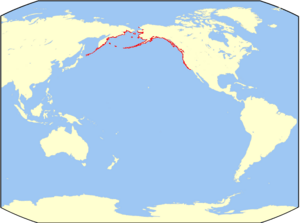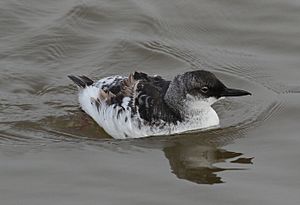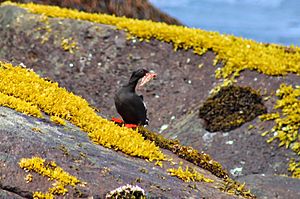Pigeon guillemot facts for kids
Quick facts for kids Pigeon guillemot |
|
|---|---|
 |
|
| Adult in breeding plumage | |
| Conservation status | |
| Scientific classification | |
| Genus: |
Cepphus
|
| Species: |
columba
|
 |
|
| Range | |
The pigeon guillemot (Cepphus columba) is a type of seabird that belongs to the auk family. It's one of three species in its group, called Cepphus. This bird is most closely related to the spectacled guillemot.
There are five different kinds, or subspecies, of the pigeon guillemot. When they are ready to breed, all of them are dark brown with a shiny black look. They have a special white patch on their wings with a dark wedge in the middle. When they are not breeding, their top feathers are a mix of grey and black, and their belly is white.
The pigeon guillemot has a long black beak and black claws. Its legs, feet, and the inside of its mouth are bright red. It looks a lot like the black guillemot, but the black guillemot is a bit smaller and doesn't have the dark wedge on its wing.
This seabird lives along the coasts of the North Pacific Ocean. You can find it from Siberia all the way through Alaska to California. Pigeon guillemots build their nests and sometimes rest on rocky shores, cliffs, and islands near shallow water. In winter, some birds move south if the ice gets too thick, while others move north in warmer areas. They usually like places that are more sheltered.
Pigeon guillemots eat small fish and sea creatures that live near the ocean floor. They catch their food by diving underwater. These birds usually have one partner for life and build their nests in small groups near the shore. They protect a small area around their nest, where they lay one or two eggs. Both parents take turns sitting on the eggs and feeding the baby birds. Once the young bird leaves the nest, it can take care of itself. Other animals, like birds and mammals, sometimes eat their eggs and chicks.
The pigeon guillemot is considered a "least concern" species by the International Union for the Conservation of Nature. This means it's not currently in danger. This is because there are many of them, their numbers are steady, and they live in a very wide area. However, things like climate change, new predators, and oil spills can still be a problem for these birds.
Contents
About the Pigeon Guillemot
The pigeon guillemot is one of three types of auk birds in the Cepphus group. The other two are the black guillemot, found in the Atlantic Ocean, and the spectacled guillemot, found in the Eastern Pacific.
Scientists first described the pigeon guillemot in 1811. Studies of their DNA show that the Cepphus group is most closely related to the murrelets, which are another type of seabird. Within the Cepphus group, the pigeon guillemot and the spectacled guillemot are like close siblings, and the black guillemot is a bit different from them. The pigeon guillemot and the black guillemot together form a "superspecies," meaning they are very similar but live in different places.
|
|||||||||||||||||||||
| This diagram shows how the pigeon guillemot is related to other birds. |
There are five known types of pigeon guillemot, called subspecies:
- Cepphus columba columba – found from northeast Siberia through the Bering Sea
- C. c. snowi – found in the northern and central Kuril Islands
- C. c. kaiurka – found from the Commander Islands to the west-central Aleutian Islands
- C. c. adiantus – found from the central Aleutian Islands to Washington
- C. c. eureka – found in Oregon and California
The name Cepphus comes from an old Greek word for a pale waterbird. The name columba comes from a Latin word meaning "pigeon." This is because the black guillemot was sometimes called the "Greenland dove." The names of the subspecies often come from people who studied them or places where they were found. For example, eureka comes from the motto of California, meaning "I have found it!"
What the Pigeon Guillemot Looks Like

The pigeon guillemot is a medium-sized auk. It is about 30 to 37 cm (12 to 15 in) long and weighs between 450 to 550 g (16 to 19 oz). Males and females look very similar.
In summer, when they are ready to breed, adult birds are mostly dark brown with a shiny black look. They have a white patch on their wings with a dark brown-black wedge in the middle. In winter, their upper parts are shiny black, sometimes with black edges that make them look scaly. Their belly and rump are white. The front of their head, top of their head, and around their eyes are black with white tips.
The underside of their wings is always dark. Adult birds change their feathers (moult) into their winter look between August and October. This takes about a month, and during this time, they can't fly for about four weeks. They change back into their breeding feathers between January and March.
Their legs and feet are red, and their claws are black. Their eyes are brown with a thin white ring around them. The beak is long and black, and the inside of the mouth is red.
Young pigeon guillemots look like winter adults but have brown tips on their belly feathers, making them look striped. Their upper parts have more brown feathers, and their wing patch is smaller. Their legs are grey-brown. After their first feather change, about two to three months after leaving the nest, they lose the brown belly feathers. They change into their first summer feathers later than adults, between March and May. These young birds don't have the same shiny look as adults.
The different subspecies of pigeon guillemots have slight differences in size, like their beak and wing length. Birds in the southern areas are generally larger, and those further north are smaller. The amount of white on their outer wing feathers increases in northern subspecies, except for one type where the white is less or missing.
The pigeon guillemot walks well and often stands upright. When resting, it often sits on its lower leg bones. Its wings are shorter and rounder than other auks. This helps it dive better than it flies. It can be hard for them to take off in calm weather without a running start. But once in the air, they are fast, reaching speeds of 77 km/h (48 mph). In the water, they are strong swimmers on the surface using their feet. When diving, they use both their wings and, unusually for auks, their feet to move. Pigeon guillemots have been seen swimming 75 m (246 ft) horizontally underwater during dives.
The pigeon guillemot is similar to the black guillemot. But you can tell them apart because the pigeon guillemot is larger. Also, during breeding season, it has dusky-grey underwings and a dark brown wedge on its white wing patch.
Where They Live
The pigeon guillemot lives across the Northern Pacific. You can find it from the Kuril Islands and the Kamchatka Peninsula in Siberia to the coasts of western North America, from Alaska to California. In winter, they stay closer to the sea or coasts, from the Pribilof Islands and Aleutian Islands to Hokkaido and southern California.
In Alaska, some birds move south because of the ice. Others stay in openings in the ice sheets. Further south, birds tagged in the Farallon Islands in central California have been seen moving north to Oregon and even British Columbia. They usually return to the same place where they hatched to breed. However, they sometimes move long distances after leaving the nest before settling down. For example, a chick tagged in the Farallones was later found breeding in British Columbia.
This bird's breeding places are rocky shores, cliffs, and islands near shallow water (less than 50 m (160 ft) deep). They are flexible about where they nest. The most important thing is being safe from predators. They are more often found nesting on islands away from the coast than on sea cliffs. In winter, they look for food along rocky coasts, often in sheltered bays. They avoid sandy-bottomed water, probably because it doesn't have the right food. Sometimes, they can be found further out at sea, near the edge of the continental shelf. In the Bering Sea and Alaska, they find food in openings in ice sheets.
Daily Life and Habits
Pigeon guillemots are usually active during the day. But they have been seen looking for food before sunrise and after sunset. They typically sleep in loose groups in calm waters or on shore near the water. They usually rest spaced apart, but mated pairs rest close together. They also bathe and clean their feathers (preen) on shore or in the sea.
Reproduction and Life Cycle
The pigeon guillemot usually lays its eggs in rocky holes near water. But they will use any available space, including caves, old burrows of other seabirds, and even old bomb casings. They are known to avoid nests with gull eggs, especially those of the western gull. These guillemots usually use the same nest site year after year. However, they won't do this if their partner doesn't return to breed. Nests can be found at many different heights, from about 1 to 55 m (3.3 to 180.4 ft) above sea level.
Pairs of birds protect their nesting site and a small area around the nest entrance (between 1–4 m2 (11–43 sq ft)). Both males and females protect the nest, but the male does most of the defending. If other birds' eggs are found in their nest, they usually remove them. Sometimes, they compete for nests with Cassin's auklets. The pigeon guillemot almost always just removes the auklet's eggs. Larger auk species, like tufted puffins and rhinoceros auklets, have been known to kick pigeon guillemots out of their nesting spots.
These guillemots nest in groups that can be very spread out or very close together. The closeness of nests usually isn't affected by predators. Birds usually arrive at the colony in the morning, and fewer are seen after early afternoon, especially when the tide is high. More birds are present when the tide is higher and fewer when it's lower. This is probably because their food is easier to get at low tide, so more birds are away from the colony. The number of birds seen changes most before they lay eggs, but it stays steady during egg laying and incubation.
Pigeon guillemots form strong pair bonds that last a long time. The pairs usually meet up again each year, though sometimes they find new partners. How they form these bonds isn't fully understood. It's thought that a type of play called "water games," where birds chase each other in and under the water, and special calls (duet-trilling) might help keep the pair bond strong or prepare them for mating. The red color inside their mouth might also be a signal to attract a mate.
They usually arrive at their breeding areas 40 to 50 days before laying eggs. Breeding happens from late April to September. During this time, they usually lay one or two eggs. The eggs have grey and brown spots near the wider end and can be creamy to pale blue-green. They are about 61.2 mm × 41.0 mm (2.41 in × 1.61 in) on average. Eggs laid later in the season tend to be longer. Both parents sit on the eggs, which usually hatch after 26 to 32 days.
The chick is kept warm (brooded) by both parents for three days straight. Then, they are brooded on and off for another two to four days. After that, the chick can control its own body temperature. Both parents feed the chicks, bringing single fish held in their beak throughout the day, most often in the morning.
The chicks usually leave the nest (fledge) 34 to 42 days after hatching. This can sometimes take anywhere from 29 to 54 days. Chicks fledge by leaving the colony and flying to the sea. After this, they are on their own and their parents no longer care for them. The adults also leave the colony. Young birds don't breed until they are at least three years old, with most breeding for the first time at four years old. While they may not breed, two or three-year-old birds might start visiting the breeding colony before they are old enough to have chicks. Pigeon guillemots that survive to adulthood live for about 4.5 years on average. The oldest known individual lived for 14 years.
Calls and Communication
The pigeon guillemot is a very noisy bird, especially during breeding season. It makes several calls to talk to other birds. Some calls are made with special movements. For example, the "hunch-whistle" involves raising the tail slightly, holding the wings out a bit, and throwing the head back while whistling. Then the head snaps back. This call tells other birds that the territory belongs to them.
Another call, the "trill," shows ownership over longer distances. Trills can be sung alone or as a duet between a pair. If it's a duet, it also helps strengthen the pair bond. Trills are usually made from a resting position. But the "trill-waggle" involves raising the tail, opening the wings, and fluffing the neck and head feathers, followed by wagging the stretched-out neck and head. This display is used when birds are in a group and often comes before an attack.
Low whistles are made by single males trying to find a mate. These are deeper than hunch-whistles and involve less head movement. Other calls include soft "seeps" and "cheeps" between mates, and "screams" when predators are nearby.
What They Eat
The pigeon guillemot looks for food alone or in small groups. It dives underwater for food, usually close to shore. During breeding season, it stays within 1 km (0.6 mi) of the colony. It dives to depths from 6 to 45 m (20 to 148 ft), but it prefers depths between 15 and 20 m (50 and 70 ft). Dives can last from 10 to 144 seconds, usually averaging 87 seconds. They rest for about 98 seconds between dives. Shorter dives (two to ten seconds) are common when they are eating schools of sandlance near the water's surface. Smaller prey are probably eaten underwater, but larger ones are brought to the surface to eat.

The pigeon guillemot mostly eats creatures that live on the sea floor (benthic prey). But it also catches some prey higher up in the water. It mainly eats fish and other water animals. Fish they eat include sculpins, sandfish, cod, and capelin. Invertebrates (animals without backbones) include shrimp and crabs, like the pygmy rock crab. Rarely, they eat worms, snails, clams, and squid.
Their diet changes a lot depending on where the bird is, the time of year, and even from year to year as ocean conditions affect what food is available. For example, they eat more invertebrates in winter. This bird's way of finding food is different from other auks. It hangs upside down above the seafloor, poking its head around for food. It uses its feet and wings to stay in place. The chicks' diet is a bit different, with more fish than invertebrates, especially rockfish. When a pigeon guillemot specializes in certain prey for its chicks, it usually means more chicks survive and grow better, especially with a diet high in fats.
An adult pigeon guillemot needs about 20% of its own weight in food each day, which is about 90 grams (3.2 oz). It doubles how much it fishes when it's feeding its nestlings. As the nestlings get older, they are fed more, until about 11 days after hatching, when the amount of food usually stays the same. However, the amount of food they get starts to decrease about 30 days after hatching.
Dangers and Health
Birds that eat eggs are the most common reason for egg loss in pigeon guillemots. Animals that prey on their nests include the northwestern crow, which eats both eggs and chicks. Glaucous-winged gulls, stoats, and garter snakes also prey on them. Raccoons are common predators, eating eggs, chicks, and even adult birds. Adult guillemots are sometimes hunted by bald eagles, peregrine falcons, great horned owls, and northern goshawks. In the water, they have been seen being caught by orcas and giant Pacific octopuses.
This bird, especially its chicks, can get a fungal disease called Aspergillus fumigatus when in captivity. They can also get a tapeworm called Alcataenia campylacantha. Ticks and fleas have also been found on chicks.
Conservation Status
The pigeon guillemot is listed as a "least concern" species by the International Union for the Conservation of Nature. This is because it has a large population, estimated at 470,000 birds. Its population is stable, and it lives in a very large area, thought to be about 15,400,000 km2 (5,950,000 sq mi).
This bird is vulnerable to new predators that are brought into its habitat, such as raccoons. When these introduced predators are removed from breeding islands, the pigeon guillemot population can recover. Climate change also affects this bird negatively. Their ability to reproduce goes down when temperatures increase. They are also very sensitive to oil spills. Adults near oiled shores show signs of liver damage. Otherwise, the effects of oil spills on the pigeon guillemot are not fully clear. Unlike some seabirds, eating plastic doesn't seem to be a big problem for this species.
Images for kids
-
Aspergillus fumigatus, a fungal disease that affects this bird when in captivity
See also
In Spanish: Arao colombino para niños









